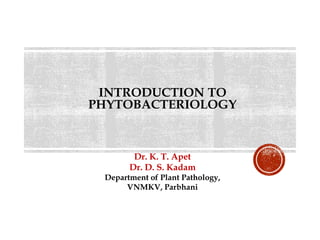
Introduction to Phytobacteriology
- 1. INTRODUCTION TO PHYTOBACTERIOLOGY Dr. K. T. Apet Dr. D. S. Kadam Department of Plant Pathology, VNMKV, Parbhani
- 2. WHAT IS PHYTOBACTERIOLOGY? Phytopathology or plant bacteriology is subdiscipline of Plant Pathology, which deals with plant associated prokaryotes and their interactions with each other and with their hosts (Dumenyo et al., 2001) Basic aspects: Morphology Physiology Taxonomy Genetics serology Applied Host-pathogen interactions pathogenesis infection process Epidemiology effect of environment on
- 3. WHY STUDY THE PHYTOBACTERIOLOGY Past emphasis: Investigation of plant diseases caused by bacteria due to heavy losses caused by these diseases. Current Scenario: The field of Phyto bacteriology has expanded considerably to include beneficial bacterial-plant interactions such as nodulation and nitrogen fixation; promotion of plant growth by phyllosphere, rhizosphere and soil-inhabiting bacteria, and control of ice-nucleation active bacteria by phyllosphere bacteria.
- 4. What is Ice Nucleation bacteria? Ice nucleation active (INA) bacteria is a group of bacteria with the ability to catalyse the ice formation at temperature above -10°C and causing frost injury in plants. Since, most of the literature on INA bacteria were from subtropical area, studies of INA bacteria from tropical area are needed. Eg. The role of ice nucleation active Pseudomonas viridiflava in frost injury to kiwifruit plants
- 5. How we can differentiate Prokaryotes with Eukaryotes?
- 6. HOW TO CHARACTERISE PROKARYOTES? Prokaryotes lack an organized nucleus and other membrane-bound organelles. Prokaryotic DNA is found in a central part of the cell called the nucleoid. The cell wall of a prokaryote acts as an extra layer of protection, helps maintain cell shape, and prevents dehydration. Prokaryotic cell size ranges from 0.1 to 5.0 μm in diameter. The small size of prokaryotes allows quick entry and diffusion of ions and molecules to other parts of the cell while also allowing fast removal of waste products out of the cell.
- 7. GENERAL STRUCTURE OF PROKARYOTE CELL
- 8. Prokaryotes comprises two groups Bacteria Archaea
- 9. HOW THEY DIFFERENTIATED? Archaea Bacteria Reproduction and Growth Asexual Reproduction, by the process of fragmentation, budding and binary fission Asexual Reproduction. Eubacteria produces spore to stay latent for several years. Cell Membrane Pseudopeptidoglycan Lipopolysaccharide/ Peptidoglycan Metabolism Activity Methanogenesis Autotrophy, Aerobic and Anaerobic Respiration, Fermentation and Photosynthesis. RNA Consists of three RNA Consists of single RNA Thriving Habitat Can sustain in extremely harsh environment such as oceans, hot springs, marshlands, hot springs and gut of humans They are generally found in soil, organic matter, earth’s crust, water, bodies of animals and plants, radioactive wastes, hot springs etc.
- 10. BACTERIA Three subgroups on the basis of Gram reaction and Cell wall a) Gram negative bacteria having cell walls b) Gram positive bacteria having cell walls c) Bacteria lacking cell walls
- 11. Gram negative bacteria having cell walls Outer membrane composed with thin peptidoglycan layer containing muramic acid Reproduction is usually by binary fission, some show budding and a very few divide by multiple fission. occur in the form of spheres, ovals, straight or curved rods, helical, or filamentous. The cells may be nonmotile or motile showing swimming or gliding motility. members may be aerobic, anaerobic, facultatively anaerobic, or microaerophlic.
- 12. Gram-positive bacteria having cell walls: No outer membrane and the peptidoglycan layer is relatively thicker than that of Gram-negative type of cell wall. shapes include rods, spheres, or filaments; the rods and filaments may show true branching. The reproduction is mostly by binary fission but actinomycetes and their relatives produce sporogenous hyphae. some members produce spores, also called endospores (resting structure) The oxygen requirement of the members is the same as that of Gram-negative bacteria.
- 13. Differentiation on cell wall basis
- 14. Bacteria lacking cell walls: They are commonly called the "Mycoplasmas" (also called mollicutes or soft-skin microorganisms). They lack the cell wall but are enclosed, plasma membrane. they lack the cell wall (peptidoglycan layer) they are not sensitive to β-lactam antibiotics or other antibiotics, which inhibit cell wall synthesis. They are highly pleomorphic, and some forms are filterable. Cells stain Gram negative no resting forms are produced, and usually they are nonmotile but some members show gliding motility. Different modes of reproduction budding, binary fission, fragmentation
- 15. Most members require complex media and require cholesterol or related sterols for growth The typical colony under adequate growth conditions is biphasic having fried-egg appearance The mol% G + C contents of r RNA (43 - 48) and of DNA (23 - 46) are lower than that of walled bacteria.
- 17. ARCHAEA Inhabitants of terrestrial and aquatic habitats, are found in anaerobic, hypersaline, or hydrothermally and geothermally heated environments. Some members also live symbiotically in the digestive tracts of animals. Mesophiles and thermophiles Grow as aerobes, anaerobes, and facultative anaerobes. Cell walls do not contain murein, peptidoglycan containing muramic acid, hence archaea insensitive to 𝛽-lactam antibiotics All archaea contain glycerol isopranyl ether lipids Spherical, spiral, plate or rod.
- 18. The modes of reproduction include binary fission, budding, fragmentation, constriction or mechanisms not yet known. The cell masses exhibit a variety of colours including red, pink, purple, green, yellow, gray, white, etc. Five major groups recognized in archaea are given below. (A) Methanogenic archaea (B) Sulphate-reducing archaea (C) Extremely halophilic archaea (D) Cell wall-lacking archaea (E) Extremely thermophilic s°-metabolising
- 19. ECONOMIC IMPORTANCE OF PHYTOPATHOGENIC PROCARYOTES Pathogen Disease Loss (mUSD) Ralstonia solanacearum Bacterial wilt of tomato and tobacco 9.4 Agrobacterium tumefaciens Crown gall of fruit and nut 23.0 Erwinia amylovora Fire blight of pear 4.7 Pectobacterium atrosepticum Black leg and/or soft rot of potato 14.0 Pseudomonas savastanoi pv. glycinea Bacterial blight of soybean 65.0 Psm. syringae pv. syringae Bacterial leaf blight of wheat 18.0 Leifsonia xyli subsp. xyli Ratoon stunting disease of sugarcane 10.0
- 20. THANK YOU!